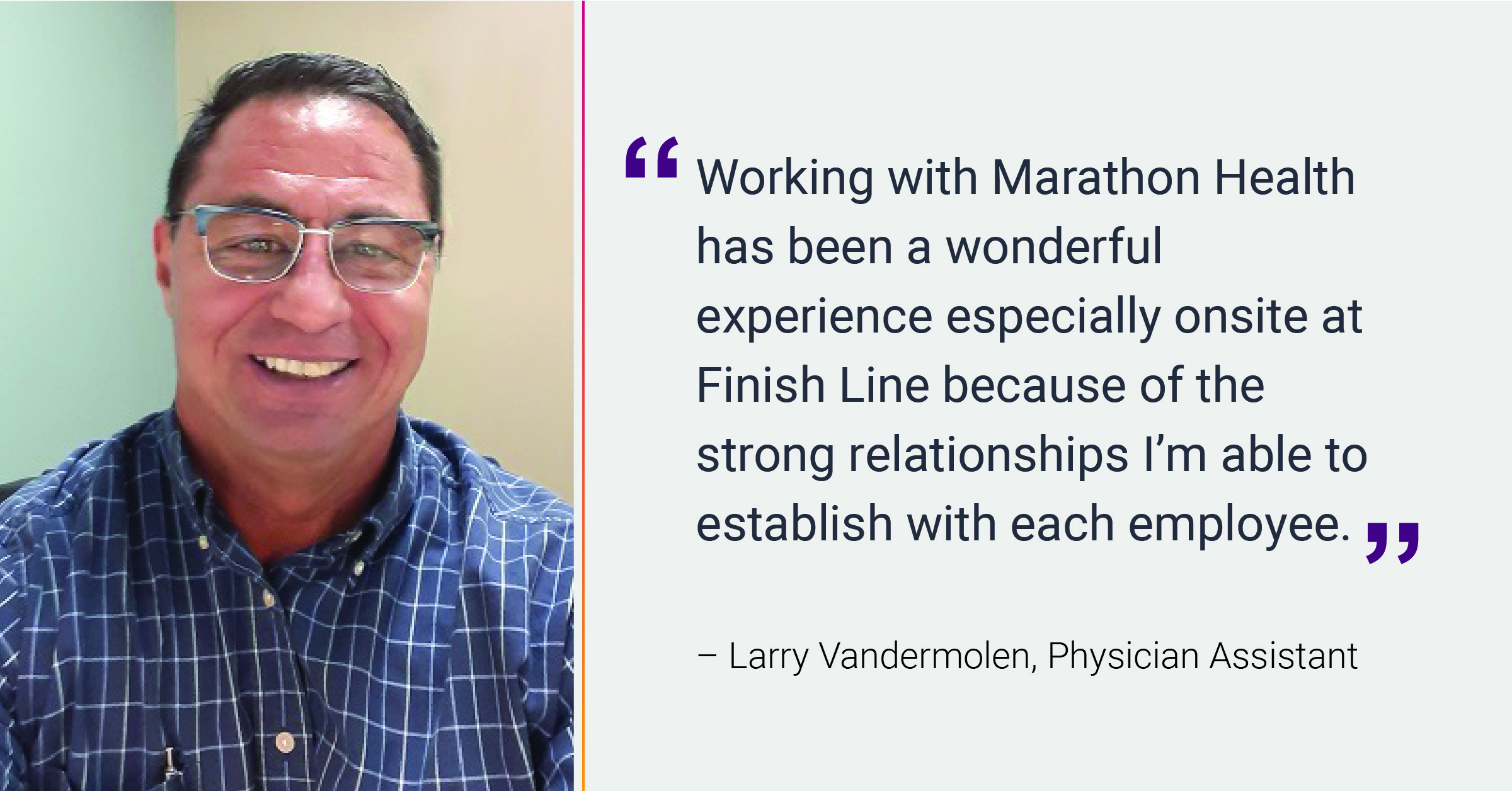A Day in the Life: Occupational Health Provider Helps Employees Heal from Worksite Injuries
July 26th, 2022 | 3 min. read

Marathon Health’s one-on-one series highlights the role different care providers play in improving employee health at the worksite, at a nearby Network health center or virtually. In this blog, I visited physician assistant Larry Vandermolen who has worked in occupational health for over 10 years.
When HR managers consider occupational health, paperwork for workers’ compensation and expensive trips to urgent care facilities often come to mind. But did you know there’s a way to reduce the headaches that come with this process? When occupational health services are onsite, HR managers can streamline the workers’ compensation process while providing their employees with high-quality healthcare at an affordable price. I spent the day with an onsite occupational health provider to learn more and see what the process entails.
Larry Vandermolen is a physician assistant with Marathon Health and is in charge of occupational health services at Finish Line’s onsite health center in Indianapolis, Indiana. He treats employees who suffer from everything from back injuries to broken bones. “Most of the employee population I treat work at the distribution center,” Vandermolen says. “I see a lot of injuries due to employees who aren’t following the correct protocol for things like lifting heavy objects or they may have tripped over a pallet while unloading a truck.”
Occupational Health Supports Employees Needs After Injuries
When an employee is injured, Larry says he first reviews all of the paperwork from the employee’s supervisor on how the injury occurred. He then talks to the employee to do a general assessment so he can make recommendations on any work restrictions. “I’ll share this information with HR so they can decide if the employee will need to be reassigned to another job temporarily while they heal,” he adds.
The recovery process almost always involves physical therapy. “One of the advantages is that we have a physical therapist onsite. If I determine an employee’s injury should be treated with physical therapy, I can schedule an appointment so they can start therapy right away. I can also consult with the therapist on how they’re progressing.”
When dealing with workers’ compensation, Vandermolen is required to document everything. He says an onsite physical therapist makes tracking paperwork easier and expedites the process.
Physical Therapy is the Key to Recovery
Once an employee starts physical therapy, Larry follows up with them about two weeks later to see how he/she is progressing. After two weeks of physical therapy, he does another assessment to check for mobility issues and any ongoing pain to determine next steps. “That can include everything from tapering off on medication and therapy, to referring them to a specialist if things aren’t improving,” he says. “If it’s a more complex issue I’ll refer them to a specialist, but nine out of 10 times we can treat them onsite.”
Vandermolen says most employees can start the process at the onsite health center, but if an incident occurs when the health center is closed, employees must visit an off-site urgent care facility which can present some obstacles. “Our goal is to keep people from going offsite to an ER or urgent care facility but our distribution center is open 24/7 and has three shifts of workers so if an injury occurs after the clinic has closed, they have to go to an offsite facility for an evaluation and sometimes their initial treatment. When you’re dealing with workers’ compensation you have to document everything so when employees have to go offsite to receive treatment, it makes the process more challenging.”
Primary Care and Occupational Health Can Go Hand-in-Hand
While getting treated for injuries is a common reason employees visit the health center, Vandermolen says that most employees come in for traditional primary care services. “I had a patient who got poison ivy over the weekend who decided to come in before work to get some medication from our onsite dispensary. The majority of the employees I treat are for common ailments like sinus infections or are coming in for a wellness screening. Finish Line provides incentives to employees who participate in regular preventive care so wellness visits are the majority of appointments we receive.”
Jim Hill, Public Safety Director for Marathon Health says that occupational health and primary care can go hand-in-hand. “We provide primary care for working people,” Hill says. “When employers provide incentives for their employees to receive things like biometric screenings, it’s easier for our providers to create a relationship with them and they’re more likely to report injuries when they happen at work before they become more severe.”
Vandermolen agrees: “If employees come in seeking primary care services, we can start to develop a rapport with them to build their trust so they’ll be more inclined to seek treatment sooner if they’re injured. Working with Marathon Health has been a wonderful experience especially onsite at Finish Line because of the strong relationships I’m able to establish with each employee. They will frequently visit us at the clinic if they happen to be in the vicinity. It’s been a privilege and honor to help them to the best of my abilities.”
Occupational Health Saves Employers Money
For employers who already have an employer-sponsored primary care provider, the biggest perk to adding occupational health services is the cost savings. “The more educated employees are about their health, the more cost savings employers are going to see,” Vandermolen says. “Whether it’s making sure they’re establishing proper protocols and training for employees to reduce injuries or providing them with wellness screenings, employers are going to experience better outcomes through a healthier employee population.”